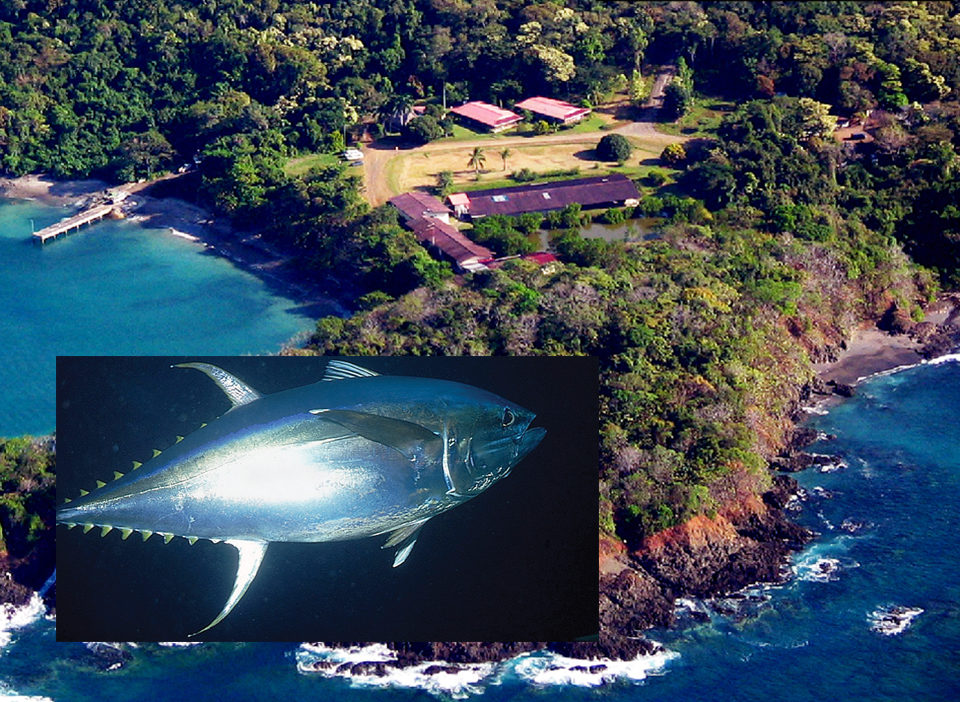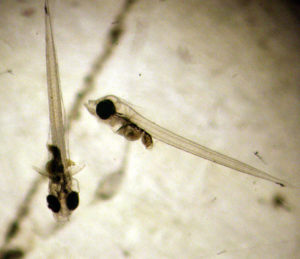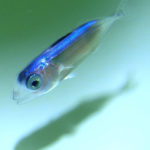Panama facility one of world’s premier tuna research labs

The Inter-American Tropical Tuna Commission (IATTC) operates the Achotines Laboratory in the Republic of Panama, where captive yellowfin tuna, Thunnus albacares, have been spawning almost daily since 1996. The Achotines Laboratory is the only facility in the world with nearly year-round availability of tuna eggs and larvae for research purposes.
The yellowfin eggs, larvae and juveniles resulting from the spawns are used for a variety of studies, including investigations of the effects of various environmental and biological factors on growth and survival of tuna in their early life stages.
Research focuses on areas of tuna ecology and biology that will provide important information for population estimates and management of the stocks. Results of studies of growth and survival of young tuna conducted at the laboratory also have strong applications in the development of closed-cycle aquaculture of tuna.
The research is carried out by members of the Early Life History (ELH) Research Group of the IATTC. Researchers from other institutions also carry out investigations at Achotines Laboratory, often in collaboration with the IATTC scientists.
Laboratory site, facilities
The laboratory is adjacent to Achotines Bay in the province of Los Santos, on the southeastern tip of the Azuero Peninsula on the Pacific coast of Panama. The annual range of sea surface temperature in these waters is approximately 21 to 29 degrees-C. The continental shelf off Achotines Bay is quite narrow. The water reaches depths of over 200 m less than 8 km from shore, affording scientists ready access to oceanic waters where tuna spawning occurs during every month of the year.
The research facilities of the Achotines Laboratory include one 1,300-m3, two 170-m3 and three 85-m3 circular concrete tanks for broodstock fish, all contained in a 1,300-m2 roofed, open-walled building. Other buildings contain facilities for incubating eggs, rearing larvae and juveniles, and producing algae and rotifers for feeding the fish, as well as analytical, nutrition and DNA laboratories, housing and office space.
Yellowfin broodstock
In early 1996, with financial assistance from the Overseas Fishery Cooperation Foundation of Japan, a yellowfin broodstock population was first established by IATTC in land-based tanks at the Achotines Laboratory. Over the past 16 years, yellowfin have been caught in waters close to Achotines Bay and transported to the laboratory in tanks aboard skiffs.
Prior to stocking in the laboratory tanks, the fish are measured, weighed, tagged with a microchip implant in the dorsal musculature for identification and injected with oxytetracycline, which establishes a temporal mark in the otoliths and vertebrae that is useful for growth studies of the fish.
The 1,300-m3 main tuna broodstock tank was designed to be large enough to reduce the stress of captivity and enhance the chances of yellowfin spawning. Since 1996, multiple groups of yellowfin have been maintained in the main broodstock tank. The average residency time has been approximately two years, although some individual fish have been held up to six years.
The broodstock yellowfin are fed a diet of squid, herring and anchovies – supplemented with vitamins and minerals – at 2.0 to 4.5% of their body weight per day. Growth rates for yellowfin that survived in the main tank at least a year have ranged 7-33 kg/year. Over 16 years, the broodstock population in the main tank has ranged from a maximum of 45 fish to a minimum of five fish. In February, the tank contained 13 yellowfin, ranging in weight from about 13 to 75 kg.
Yellowfin spawning
Yellowfin tuna in the main broodstock tank have been spawning almost daily since October 1996. To our knowledge, this represents the only successful long-term spawning of yellowfin in land-based tanks in the world. Spawning generally occurs from early afternoon to late evening. The spawning events are usually preceded by several hours of courtship behavior that includes paired swimming and chasing.
The numbers of fertilized eggs collected after each spawning event range from several hundred to several million. The eggs are collected by several methods, including siphoning, dip netting at the surface and seining with a fine-mesh egg seine.
The larvae hatched from eggs spawned in captivity at the Achotines Laboratory are used in a variety of laboratory experiments. The IATTC’s ELH group has described the growth, survival and early development of yellowfin tuna in several publications. The experimental program at Achotines Laboratory has led to advances in the rearing of larval and early-juvenile tuna. IATTC scientists routinely rear early-juvenile yellowfin tuna up to 30 to 60 days after hatch for research purposes, and have reared yellowfin up to 100 days after hatch.
Recent trials

Experimental topics of study with yellowfin have expanded in recent years. The effects of ocean acidification are receiving increased attention worldwide. For tuna, early life stages are sensitive to environmental changes, but the potential impacts of ocean acidification on tuna populations are unknown.
Research trials completed at the Achotines Laboratory in late 2011 examined the potential effects of ocean acidification on the survival and growth of yellowfin eggs and larvae. These trials were conducted in collaboration with scientists from the Secretariat of the Pacific Community and funded by the Pelagic Fisheries Research Program of the University of Hawaii.
In 2010 and 2011, eggs and/or larvae of yellowfin tuna were successfully shipped by air from the Achotines Laboratory to the Hubbs Sea World Research Institute (HSWRI) in San Diego, California, USA, as part of a feasibility study funded by the Saltonstall-Kennedy Program of the U.S. National Oceanic and Atmospheric Administration. The success of the project was instrumental in IATTC and HSWRI being awarded a California Sea Grant project designed to continue and expand the air shipment trials. The new project began in May 2012 and will continue for three years.
Studies of yellowfin, pacific bluefin

In January 2011, IATTC, Kinki University of Japan and the Autoridad de los Recursos Acuáticos de Panamá (ARAP) began a comparative study of the early life history and reproductive biology of yellowfin tuna and Pacific bluefin tuna. This joint research project is being conducted by faculty and staff of Kinki University, the ELH group of the IATTC and scientists of ARAP, mostly at the Fisheries Laboratory of Kinki University and the Achotines Laboratory, and will continue through March 2016.
The study will be the first in the world to investigate important comparative aspects of the reproductive biology, genetics and early life history of these two species of tuna. The project is being implemented under the Science and Technology Research Partnership for Sustainable Development. The studies conducted in Japan are supported by the Japan Science and Technology Agency, and those in Panama by the Japan International Cooperation Agency.
Annual workshops
Since 2003, IATTC and the University of Miami’s Aquaculture Program have jointly hosted an annual workshop entitled “Physiology and Aquaculture of Pelagics with Emphasis on Reproduction and Early Developmental Stages of Yellowfin Tuna” at the Achotines Laboratory. International researchers, industry professionals and University of Miami graduate students gather to study and share advanced technologies and improved methods for experimental studies and rearing of larval tuna and other species of marine fish. A fee for the participants and students covers the expenses of conducting the workshops.
Future directions
From modest beginnings, IATTC’s Achotines Laboratory has developed into one of the premier tuna research laboratories in the world. With high-quality research facilities situated in a tropical environment, the Achotines Laboratory provides researchers with a unique setting for conducting research on tropical tuna, especially yellowfin tuna.
Editor’s Note: For descriptions of research programs and a full list of scientific publications based on research conducted at the Achotines Laboratory, visit the laboratory website at www.iattc.org/AchotinesLab/AchotinesDefaultENG.htm.
(Editor’s Note: This article was originally published in the March/April 2013 print edition of the Global Aquaculture Advocate.)
Authors
-
Daniel Margulies, Ph.D.
Inter-American Tropical Tuna Commission
8901 La Jolla Shores Drive
La Jolla, California 92037 USA -
Vernon P. Scholey, M.S.
Inter-American Tropical Tuna Commission
8901 La Jolla Shores Drive
La Jolla, California 92037 USA -
Jeanne B. Wexler
Inter-American Tropical Tuna Commission
8901 La Jolla Shores Drive
La Jolla, California 92037 USA -
Maria S. Stein
Inter-American Tropical Tuna Commission
8901 La Jolla Shores Drive
La Jolla, California 92037 USA
Tagged With
Related Posts

Innovation & Investment
Aquaculture Exchange: Daniel Benetti
University of Miami professor says the U.S. seafood marketplace needs to embrace 'plate-sized' fish if a domestic aquaculture industry is to become sustainable and profitable.

Intelligence
Aquaculture key to increasing seafood supplies to Arab states
Arab States have substantial natural resources to increase aquaculture production. Several types of systems are readily adaptable and can be implemented relatively quickly.

Innovation & Investment
Aquaculture Exchange: Barry Costa-Pierce, UNE
University of New England Professor Barry Costa-Pierce says aquaculture is often neglected in studies examining ocean health and ecosystem and resource management. The “Ocean Prosperity Roadmap” released this summer, he said, was more of the same.

Innovation & Investment
Tuna aquaculture: Fishing for progress
Aquaculture could be a sustainable alternative to fishing for tuna but achieving commercial-scale production has proven challenging.


